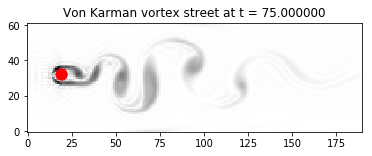Von Karman vortex street¶
In this tutorial, we consider the classical \(\DdQq{2}{9}\) to simulate the Von Karman vortex street modeling by the Navier-Stokes equations.
In fluid dynamics, a Von Karman vortex street is a repeating pattern of swirling vortices caused by the unsteady separation of flow of a fluid around blunt bodies. It is named after the engineer and fluid dynamicist Theodore von Karman. For the simulation, we propose to simulate the Navier-Stokes equation into a rectangular domain with a circular hole of diameter \(d\).
The \(\DdQq{2}{9}\) is defined by:
a space step \(\dx\) and a time step \(\dt\) related to the scheme velocity \(\lambda\) by the relation \(\lambda=\dx/\dt\),
nine velocities \(\{(0,0), (\pm1,0), (0,\pm1), (\pm1, \pm1)\}\), identified in pylbm by the numbers \(0\) to \(8\),
nine polynomials used to build the moments
where \(E = X^2+Y^2\).
three conserved moments \(\rho\), \(q_x\), and \(q_y\),
nine relaxation parameters (three are \(0\) corresponding to conserved moments): \(\{0,0,0,s_\mu,s_\mu,s_\eta,s_\eta,s_\eta,s_\eta\}\), where \(s_\mu\) and \(s_\eta\) are in \((0,2)\),
equilibrium value of the non conserved moments
where \(\rho_0\) is a given scalar.
This scheme is consistant at second order with the following equations (taken \(\rho_0=1\))
with \(p=\rho\lambda^2/3\).
We write a dictionary for a simulation of the Navier-Stokes equations on \((0,1)^2\).
In order to impose the boundary conditions, we use the bounce-back conditions to fix \(q_x=q_y=\rho v_0\) at south, east, and north where the velocity \(v_0\) could be \(v_0=\lambda/20\). At west, we impose the simple output condition of Neumann by repeating the second to last cells into the last cells.
The solution is governed by the Reynolds number \(Re = \rho_0v_0d / \eta\), where \(d\) is the diameter of the circle. Fix the relaxation parameters to have \(Re=500\). The relaxation parameters related to the bulk viscosity \(\mu\) should be large enough to ensure the stability (for instance \(\mu=10^{-3}\)).
We compute the stationary solution of the problem obtained for large enough final time. We plot the vorticity of the solution with the function imshow of matplotlib.
[1]:
%matplotlib inline
[2]:
import numpy as np
import sympy as sp
import pylbm
X, Y, LA = sp.symbols('X, Y, LA')
rho, qx, qy = sp.symbols('rho, qx, qy')
def bc_in(f, m, x, y):
m[qx] = rhoo * v0
def vorticity(sol):
ux = sol.m[qx] / sol.m[rho]
uy = sol.m[qy] / sol.m[rho]
V = np.abs(uy[2:,1:-1] - uy[0:-2,1:-1] - ux[1:-1,2:] + ux[1:-1,0:-2])/(2*sol.domain.dx)
return -V
# parameters
rayon = 0.05
Re = 500
dx = 1./64 # spatial step
la = 1. # velocity of the scheme
Tf = 75 # final time of the simulation
v0 = la/20 # maximal velocity obtained in the middle of the channel
rhoo = 1. # mean value of the density
mu = 1.e-3 # bulk viscosity
eta = rhoo*v0*2*rayon/Re # shear viscosity
# initialization
xmin, xmax, ymin, ymax = 0., 3., 0., 1.
dummy = 3.0/(la*rhoo*dx)
s_mu = 1.0/(0.5+mu*dummy)
s_eta = 1.0/(0.5+eta*dummy)
s_q = s_eta
s_es = s_mu
s = [0.,0.,0.,s_mu,s_es,s_q,s_q,s_eta,s_eta]
dummy = 1./(LA**2*rhoo)
qx2 = dummy*qx**2
qy2 = dummy*qy**2
q2 = qx2+qy2
qxy = dummy*qx*qy
print("Reynolds number: {0:10.3e}".format(Re))
print("Bulk viscosity : {0:10.3e}".format(mu))
print("Shear viscosity: {0:10.3e}".format(eta))
print("relaxation parameters: {0}".format(s))
dico = {
'box': {'x': [xmin, xmax],
'y': [ymin, ymax],
'label': [0, 2, 0, 0]
},
'elements': [pylbm.Circle([.3, 0.5*(ymin+ymax)+dx], rayon, label=1)],
'space_step': dx,
'scheme_velocity': la,
'parameters': {LA: la},
'schemes': [
{
'velocities': list(range(9)),
'conserved_moments': [rho, qx, qy],
'polynomials': [
1, LA*X, LA*Y,
3*(X**2+Y**2)-4,
(9*(X**2+Y**2)**2-21*(X**2+Y**2)+8)/2,
3*X*(X**2+Y**2)-5*X, 3*Y*(X**2+Y**2)-5*Y,
X**2-Y**2, X*Y
],
'relaxation_parameters': s,
'equilibrium': [
rho, qx, qy,
-2*rho + 3*q2,
rho-3*q2,
-qx/LA, -qy/LA,
qx2-qy2, qxy
],
},
],
'init': {rho:rhoo,
qx:0.,
qy:0.
},
'boundary_conditions': {
0: {'method': {0: pylbm.bc.BouzidiBounceBack}, 'value': bc_in},
1: {'method': {0: pylbm.bc.BouzidiBounceBack}},
2: {'method': {0: pylbm.bc.NeumannX}},
},
'generator': 'cython',
}
sol = pylbm.Simulation(dico)
while sol.t < Tf:
sol.one_time_step()
viewer = pylbm.viewer.matplotlib_viewer
fig = viewer.Fig()
ax = fig[0]
im = ax.image(vorticity(sol).transpose(), clim = [-3., 0])
ax.ellipse([.3/dx, 0.5*(ymin+ymax)/dx], [rayon/dx,rayon/dx], 'r')
ax.title = 'Von Karman vortex street at t = {0:f}'.format(sol.t)
fig.show()
Reynolds number: 5.000e+02
Bulk viscosity : 1.000e-03
Shear viscosity: 1.000e-05
relaxation parameters: [0.0, 0.0, 0.0, 1.4450867052023122, 1.4450867052023122, 1.9923493783869939, 1.9923493783869939, 1.9923493783869939, 1.9923493783869939]

[ ]:
